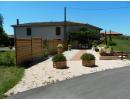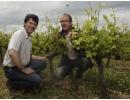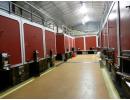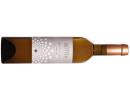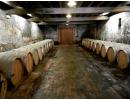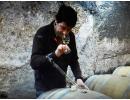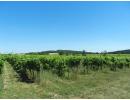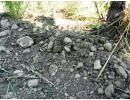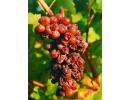Domaine Rotier
Domaine Rotier “Renaissance” 2014 - Gaillac Vendanges Tardives (late harvest)
The premium dessert wine of the Domaine, made with the local indegenous grape Loin de l'Oeil. The bunches are hand harvested at full maturity when they are fully affected by the botrytis (noble rot). It usually takes 3 to 4 successive pickings over a period of 2 to 3 weeks, producing a low yield of 15 to 25 hl/ha depending on the vintage. This process will produce a wine reaching a residual sugar of 170 to 200g/l depending on the vintage. Following the pressing, the fermentation is carried out in French oak barrels of 400 litres at 18°C, which can take up to 2 months depending on the richness of the juice. The wine is aged in french oak and acacia barrels for a period of 10 months with only 15% of new oak.
PVins notes: With the use of large barrels increasing the ratio of juice to wood and a small percentage of new oak, the wine is not marked by the oak. This enables the grape to express its full aromatic potentials. The wine is gold in colour with an expressive aromatic range of exotic confit fruits, it is rich, concentrated and well-balanced by its natural freshness. The complex sweet exotic fruit flavours just linger on the palate. The wine may be cellared over 15+ years.
Press:
Wine Enthusiast 92
The Loin de l'Oeil grape lends itself easily to creating this rich, honeyed wine. It's intense, with a viscous texture and opulent apricot and bitter marmalade flavors. Drinkable now for its concentration, it will get even better from late 2018.
Jancis Robinson 16.5
Smells, extraordinarily, just like super-ripe mango and guava. Silky, seductively, lusciously sweet and textured. So sweet that my top lip broke out in a sweat! Could do with a smidge more acidity, but by the droplet this wine is glorious. Drink 2018 - 2024
Decanter 92
Intense fruit of dried peach and anise on the nose. Rich on the palate with a pleasant botrytis finish and real personality.
Awards:
Concours Général Agricole Paris 2016 - Gold Medal
Challenge millésime bio (organic) 2018 - Gold Medal
Domaine Rotier is located south-east of town Gaillac at the lieu-dit “Petit Nareye” on the commune of Cadalen. The Petit Nareye, which constitutes most of Domaine Rotier, has been known to man for a very long time, as several tools made from quartz dating from the Paleolithic Age (150 to 200 000 years ago) have been found here. But the story of the Domaine starts with Gérard ROTIER and his wife Michèle, Alain’s parents. They settled in 1961 in the area at "La Pélisserie" before purchasing the the abandoned vineyard of "Petit Nareye" in 1975.
In 1985, Alain got involved in the running of the estate with his parents and decided to stop selling the grapes to the local co-operative to set up their own cellar as Domaine Rotier. From that day on, particular attention and care was taken in the management and maintenance of the vines and soils. In 1990 the cellar was improved and extended with a further extension in 1999 that included the installation of an air-conditioning system for maturing and storing the wines. In 1997, Alain’s brother-in-law Francis Marre joined him on the estate enabling Gérard and Michèle Rotier to retire. Alain looks after the wine making, sales and maketing, while Francis looks after the management of the 35 ha of vines.
Alain always believed in the potential of the local grapes varieties. In 1985, he decided to replant some long forgotten local grapes such as the now famous "Loin de L'Oeil" or in the local dialect "Len de l'El" meaning "Far from the Eye". He soon gained a reputation for his botrytis wine made with "Loin de l'Oeil". The wine is now considered to be a banchmark for this particular grape vareiety as a dessert wine in the appellation Gaillac. Alain is now also considered by the French wine critics to be amongst the best producers of dessert wines in France.
French version
In 2001, Alain and Francis decided to increase the density of vines with new plantations and went from 4,000 vines per hectare to 6,170 vines. The change increased the rivalry between vines, a larger surface of leaves was encouraged to develop what is necessary per kilo of grapes to improve the maturity of the grapes. This change would also produce smaller bunches per vine that are more concentrated and richer, extracting more of the essence of the terroir. In 2005, they started to implement a more ecological approach to viticulture by abandoning chemical treatments and starting some trials with organic farming, with the aim of making wines that are more natural and authentic. In 2009, they started a full organic conversion of the estate by encouraging microbiological diversity in the vineyard, after three years of hard work the estate received the organic certification in 2012.
The 35 ha of Domaine Rotier are located on the left bank of the Tarn River. They are mainly planted with local grape varieties with 25 ha of red grapes and 10 ha of white grapes. The red grape varities are Duras, Braucol, Syrah and Prunelart since 2009 and the white grapes are Loin de l'Oeil and Sauvignon Blanc. The vineyard is planted on a plateau corresponding to the 2nd terrace of the Tarn river composed of gravelly soils made up of the middle alluvial terrace of the Tarn River. Situated at 200 metres in altitude, this terrace dates from the Riss geological period, somewhere between 130,000 and 300,000 years ago. Under these ancient alluviums, about 1.5 to 3 metres in thickness, are found much older marls dating about 32 million years. The land here is relatively poor and stony providing good drainage, the soils warms up very quickly in the spring and becomes very dry in summer helping to produce low yields.
The climate here is predominantly oceanic, with a Mediterranean influence, due to the south wind “Vent d’Autan”. This dry, hot wind loses its sea moisture as it crosses the Montagne Noire range, which separates the Lower Languedoc from the Upper Languedoc and continues toward the hills of the Tarn. The wind is responsible for warm, dry periods during the autumn which provide the best conditions for optimal maturation of the red grapes, while obtaining high concentration for the white grapes. These conditions are particularly important for the grape "Loin de l’Oeil" to produce the Gaillac Vendanges Tardives (late harvest) with noble rot.
The estate produces a range of wines which includes reds ,dry whites, a rosé and late harvest wines. The first range of wines named "Les Gravels" are early to medium term drinking wines. They are fermented and aged in stainless steel vats to keep the freshness of the flavours and a fruity side. The flagship wines are the cuvées "Renaissance Red" and "Renaissance" Vendanges Tardives both offering a very good cellaring potential. Old vines of Duras and Braucol from the best parcels including some Prunelart are used for the red wine and the grape Loin de l'Oeil is used for the white late harvest. Both wines are aged in oak barrels for up to a year with very little new oak. Since 2008, a new premium wine named "L'Ame" meaning "Soul" is produced, the idea is to show the soul of Gaillac made from two local grapes varieties Duras and Braucol. As for the winemaking of the red wines, the bunches are destemmed and the grape varieties are fermented separately for 3 to 5 weeks, a minimum amount of micro-oxygenation is done to increase the aromatic complexity.
Alain Rotier is also very well know for the rebirth of the grape Loin de L'Oeil in Gaillac, especially for its potential as a great dessert wine. Over the years, Alain's "Renaissance" Vendanges Tardives has acquired recognition to be amongst the best dessert wines of France for its richness, balance and aromatic complexity vintage after vintage. The grapes are handpicked with multiple "tries" over 2 to 3 weeks to let the botrytis fully develop on the grapes. After a slow press, the must will slowly ferment in 400 litres oak barrels for 1 to 2 months before the ageing process in french oak and accacia barrels (15% new) for a period of 10 months. The end result is a wine that shows complex aromas and a perfect balance between the acidity and the residual sugar, which averages 150g/l depending on the vintage.
French version
Links: South-West map - www.vins-galliac.com
GAILLAC
The Gaillac appellation, created in 1938, is located in the Tarn department about 50 kilometers northeast of Toulouse. The appellation covers 4,200 hectares with the town Gaillac at its heart, it is also part of the greater wine region known as the "Sud-Ouest" South-West.
History
Gaillac's vineyards were established in the 1st century BC by the Romans and they are known to have transported wines from the area to Bordeaux and Northern Europe via the Tarn River. In the Middle-Ages, the town of Gaillac expanded around the Benedictine monastery Saint -Michel, the vineyards flourished in the care of the monks. The export of wine from the South-West region was developed following the marriage in 1152 between Eleanor of Aquitaine and Henri II of England. The Aquitaine region with its port Bordeaux was now in the Plantagenet Empire. As the most important port of the Atlantic coast, Bordeaux exercised control over the imports and exports of goods such as wine transiting via the Garonne River from the South-West of France. King Henry III of England was known to appreciate the wines of Gaillac as he ordered 20 barrels in 1253. Unfortunately, the wars of the French Revolution and the new French Empire put a stop to the maritime trade from Bordeaux.
With the arrival of the Phylloxera in the 1860s, the vineyards were devastated and this tragedy was severe for the South-West as most of the land was used for viticulture. It almost took a century for the vineyards of the South-West such as Gaillac to recover from this dramatic crisis, also aggravated by the economic decline of the 1880s. Some growers had the opportunity to replant their vines using American rootstocks but it remained an impossible expense for many small peasant-farmers. For the first half of the 20th century, production in the region was based on volume and cheap wine until the 1956 frost that destroyed a significant part of the vineyards. This was a turning point for many of the appellations such a Gaillac, those that were determined to replant vines did so by restructuring the vineyards and replanting qualitative regional or local grapes varieties. Today, Gaillac has recovered its past glory and reputation through the hard work and passion of its winemakers.
Vineyard
The vineyards cover a vast area, from the east of the town of Albi, located east of Gaillac, to the city of Saint-Sulpice, south-west of Gaillac, the vines run along both side of the banks of the Tarn River. North of Gaillac, the vineyards start a few kilometers above the medieval city of Cordes-sur-Ciel and spread southwards 40 kilometers to Graulhet. A great diversity of terroirs characterise the vineyards of Gaillac enabling the appellation to produce a large variety of wines with personality. There are three main districts with each having its own terroir:
- Terraces on the left bank of the Tarn River: a succession of alluvial terraces, deep subsoil and well drained with the presence of several meters of sand, pebbles and gravels. A terroir of predilection for the reds, here the Duras expresses all its elegance. The wines produced are powerful, full-bodied with round tannins. White wines are less acidic than on the right bank, they are subtle with finesse. It is here that the Loin de L'Oeil grape (far from the eye) expresses its exceptional complexity with the superb Gaillac Doux "Vendanges Tardives". This is the warmest area of the appellation.
- Slopes on the right bank of the Tarn River: the surrounding is made of rolling clay and limestone hillsides. The dry whites are elegant and supple, while the dessert wines are rich and aromatic. The reds are refreshing, balanced with fruity and spicy aromas. These terroirs bring out the best in the Mauzac and Braucol grape varieties. The well exposed slopes in the area provide the white wine "Premières Côtes de Gaillac", but the vineyard's surface is very small.
- Plateau Cordais: The most Northern part of the appellation, all different styles Gaillac wines are produced. With an altitude of 200 to 300 metres, the harvest occurs 10 to 15 days after the rest of the appellation. Also with most of the vineyards facing south-west, the grapes enjoy longer periods of sunlight. The soil is rich in limestone content, providing delicate wines. White wines show refreshing floral and fruity flavours, the reds are very well balanced.
Gaillac producess grapes rarely found elsewhere such as the Duras, Braucol (Fer Servadou), Prunelart, Mauzac, Ondenc and Len de L'El locally known as Loin de L'Oeil meaning "far from the eye". These local varieties are often blended with other authorised grapes found in other regions that are grown within the Gaillac appellation. While Gaillac was mainly known for its whites such as the "blanc perlé" "perly white" in the past, the appellation is now dominated by its reds. The main red grape varieties are Duras, Braucol and Syrah which may be blended with Prunelart, Cabernet Franc, Cabernet Sauvignon and Merlot, while the main white grapes are Mauzac, Len de L'El and Muscadelle which may be blended with Sauvignon Blanc and Ondenc. The Mauzac remains the most commonly used grape for the white wines. From these various varieties different styles of wines are produced under various Gaillac appellations producing dry whites, rosés, reds, dessert wines, sparklings and since 1980 young primeur wines similar to the Beaujolais Nouveau marketing approach.
Climate
The appellation Gaillac is located at a climatic crossroad between the Atlantic and Mediterranean climate zones. The heat from the Mediterranean area combined with the ocean humidity of the Atlantic provides the perfect weather conditions for vine growing. Winegrowers will certainly mention the added bonus of the "Vent d'Autan" winds of Autan. This warm dry wind coming from the Mediterranean basin in the south is an important key element for the health of the vines and grapes. Not much rain falls between May and September as the local climate is influence by the two mountain chains the "Massif Central" to the east and the "Montage Noire" to the south-east.



